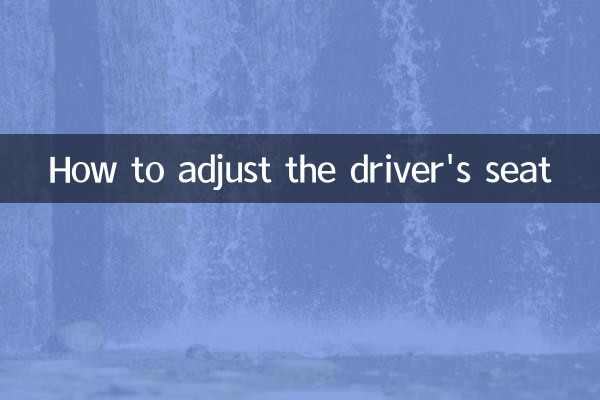How to adjust the driver's seat? Popular topics and practical guides on the Internet in the past 10 days
Recently, the topic of driver's seat adjustment has been a hot topic on social media and automotive forums. As the demand for long-distance travel increases in summer, how to scientifically adjust seats has become the focus of car owners. The following is a comprehensive guide to adjusting the driver's seat based on hot spots across the Internet.
1. Popular driving-related topics on the Internet in the past 10 days

| topic | Discussion popularity | Main platform |
|---|---|---|
| Best driver's seat angle | 187,000 | Weibo/Zhihu |
| Solution for low back pain during long distance driving | 123,000 | Autohome/Douyin |
| Electric seat memory function evaluation | 95,000 | Station B/Knowing Car Emperor |
| Comparison of seat settings for height 160cm vs 180cm | 68,000 | Xiaohongshu/Hupu |
| The difference between racing seats and ordinary seats | 52,000 | Kuaishou/Tieba |
2. Standard steps for driver’s seat adjustment
According to the latest recommendations from the Society of Automotive Engineers (SAE), the correct adjustment sequence should be:
| steps | Operational points | Reference data |
|---|---|---|
| 1. Seat height | Make sure you can see the front edge of the engine cover | It is recommended that the car should be 12-15cm above the ground |
| 2. Front and back position | The knees are slightly bent (about 120°) to fully depress the pedal. | The steering wheel should be at least 25cm away from the chest |
| 3. Backrest angle | Maintain a 100-110 degree tilt | Shoulders fit perfectly into the seat |
| 4. Headrest position | The top is level with the top of the head or slightly higher | The middle part is aligned with the auricle |
| 5. Steering wheel adjustment | The wrist can rest naturally on the rim | Does not block the view of the instrument panel |
3. Adjustment plans for drivers of different sizes
The recent Douyin topic "Small Girls Driving Challenge" (viewed 240 million times) has triggered the need for special body shape adjustment:
| Physical characteristics | solution | Popular products |
|---|---|---|
| Height<160cm | Install seat booster cushion | Japanese Car Mate booster pad (recommended by Xiaohongshu) |
| Height>185cm | Lower the seat + move the rail backward | BMW Extended Track (Forum Modification Plan) |
| People with lumbar muscle strain | Use a lumbar support cushion | Michelin 3D memory foam cushion (hot seller on JD.com) |
| late pregnancy driver | Increase seat recline angle | Safety belt for pregnant women (Tmall new product) |
4. Highlights of seat technology for new models in 2023
Three major trends were discovered from the summer evaluation of Qingchedi:
| Technology | Representative models | User ratings |
|---|---|---|
| AI adaptive adjustment | NIO ET7 | 9.2/10 |
| biometric memory | Mercedes-Benz EQS | 8.9/10 |
| health monitoring seat | Ideal L9 | 9.5/10 |
5. Expert advice and common misunderstandings
Car safety expert Wang Jianjun (3.2 million followers on Weibo) pointed out in a recent live broadcast:
1.Misunderstanding:The straighter the seat, the better →Facts:Leaning back 100-110 degrees can reduce spinal pressure
2.Misunderstanding:The headrest is just a comfort configuration →Facts:Correct settings can reduce the risk of whiplash by 75%
3.New findings:Seat heating function can relieve fatigue caused by waist moisture in summer
According to the latest traffic regulations research, improper seat adjustment will cause a reaction delay of 0.3-0.5 seconds, which is equivalent to an increase in braking distance of 6-10 meters at a speed of 80km/h. It is recommended to recalibrate the seat position every 3 months or before long-distance travel to ensure both driving safety and comfort.

check the details

check the details